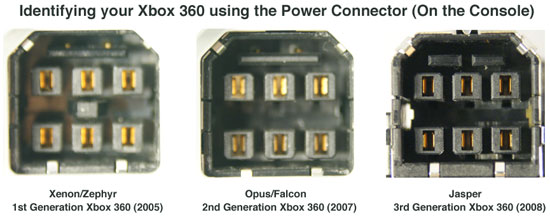Jasper Is Here: A Look at the New Xbox 360
by Anand Lal Shimpi on December 10, 2008 12:00 AM EST- Posted in
- Smartphones
- Mobile
Confirming Your Jasper
If you can physically open the box, there's another way of confirming that you have a Jasper without even opening the plastic bag that the console comes in: look at the power connector on the Xbox 360 itself. Each Xbox 360 generation has a power connector that's keyed differently so you can't use a lower powered power supply on a console that requires more power. Now all Xbox 360 power supplies will work on newer consoles, but you can't use newer power supplies on older consoles. Make sense? Let me explain:
The first Xbox 360 (Xenon) needs a 203W power supply. Falcon needs a 175W power supply but can also work with the 203W unit (it just doesn't need to draw that much power so the 203W unit is overkill, but it'll work). Jasper needs 150W but can work with a 203W and a 175W. In other words, the Xbox 360 power supplies are forwards but not backwards compatible.
If you get a Jasper it's not guaranteed that you'll get a 150W power supply, Microsoft still has a lot of Falcons and Falcon-parts in its distribution system so some Jaspers have been sighted with 175W power supplies. If you end up with a 175W unit it's not a big deal, it's going to be slightly less efficient than the 150W unit and your system may end up drawing an extra few watts but it's not a big deal at all - you'll still be far cooler/more power efficient than a Falcon (and possibly be red-ring-free).
To prevent an under powered power supply from being used in the wrong Xbox, Microsoft keyed each of the three Xbox 360 generations differently. The chart below explains it all:
If you see one flat bar on top and a square peg in the middle of the power connector on the console itself you've got a 1st generation Xenon or Zephyr board, these machines use 90nm CPUs and GPUs. If you've just got a flat bar on top with no square peg in the middle, you've got a 2nd generation Opus or Falcon board, these things use 65nm CPUs and 80nm GPUs. Finally if you've got a flat bar split in two on top with no square peg you've got a Jasper, that's a board with a 65nm CPU and a 65nm GPU.











84 Comments
View All Comments
Anand Lal Shimpi - Wednesday, December 10, 2008 - link
That was one of the original bits of speculation on the RRoD failures, I've pulled it out since I'm not sure exactly what compound MS used. It's clear that MS viewed the connection between the GPU and motherboard as an issue thanks to the glue in the Falcon and later consoles.-A
gohepcat - Wednesday, December 10, 2008 - link
Hey Anand,I know it's just anecdotal evidence that we can use to claim that the Falcon still had RROD problems, but NeoGaf has been keeping a pretty extensive tally for dead 360s and dead falcons seem to be very rare (at last count they only confirmed 1)
Do you know people with dead Falcons?
adhoc - Wednesday, December 10, 2008 - link
I think the glue is probably there to minimize stress fractures between the PCB and BGA chips which bend at different rates from the high-force heatsink. When large (both in area and weight) heatsinks are tightly fastened to PCBs (like many PC motherboards and I think the Xbox360), it causes the PCB to bend. I would suspect the glue is used as a propping mechanism so that when the PCB flexes, the BGA chip does as well starting at the glued edges rather than the solder points of the BGAs. It also might have an effect of "broadening" the flex of the PCB under the BGA so that the surface of the PCB won't be so concave between pins.Staples - Wednesday, December 10, 2008 - link
I really think the whole solder compound rumor is a myth. If it were that simple, then I am sure MS could have saved themselves a ton of money by using a different compound. It may cost a dollar more per system but it would save them 50$ a console since they would not have to replace 50% of them. Sure the solder joints may break but I doubt that it is because of it being made of the wrong material.And about the lead free solder, if that is what they are really using (which they should), it is possibly more brittle and could break under stress.
The0ne - Wednesday, December 10, 2008 - link
Typically it's not the compound but more so due to bad soldering/contact. We've recently had similar issues with a few of our PCBs and it had me chasing down the cause down to the compound as well. As it turned out their SMT was fully capable one way or another where we had lifted pins, cold joints, reverse components, etc. These data didn't really showed until we started gathering more and more data to prove it.sprockkets - Wednesday, December 10, 2008 - link
Isn't it true now that all solder has to be lead free?UltraWide - Wednesday, December 10, 2008 - link
Only if you want to be RoHS compliant.Zorlac - Wednesday, December 10, 2008 - link
I think you meant "RRoD Compliant" ;)sprockkets - Wednesday, December 10, 2008 - link
But now you cannot sell anything that is not RoHS compliant in the EU.sprockkets - Wednesday, December 10, 2008 - link
OK, AMD's presentation explained it.